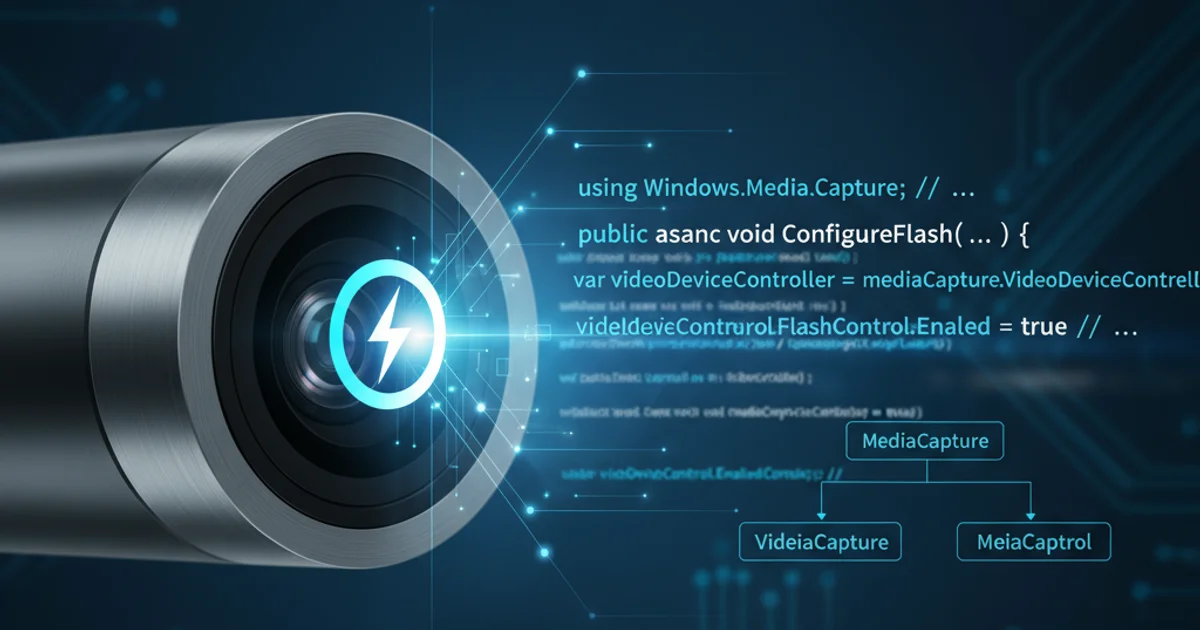How to use FlashControl (MediaCapture.VideoDeviceController)
Categories:
Mastering Flash Control with MediaCapture.VideoDeviceController in C#

Learn how to programmatically control your device's flash/torch using the MediaCapture.VideoDeviceController in C# for Windows applications, enhancing your camera functionalities.
When developing camera-enabled applications for Windows (UWP, WPF with interop), controlling the device's flash or torch mode is a common requirement. The MediaCapture.VideoDeviceController class provides access to various camera settings, including the FlashControl property. This article will guide you through the process of detecting flash capabilities, enabling/disabling the flash, and managing its different modes (on, off, auto, torch).
Understanding FlashControl Capabilities
Before attempting to control the flash, it's crucial to determine if the camera device actually supports flash functionality. Not all cameras, especially front-facing ones or virtual cameras, will have a flash. The FlashControl object, accessed via MediaCapture.VideoDeviceController.Flash, exposes properties like Supported and PowerSupported to check for these capabilities. Additionally, RedEyeReductionSupported and TorchSupported indicate more advanced flash features.
flowchart TD
A[Initialize MediaCapture] --> B{Get VideoDeviceController}
B --> C{Access FlashControl Property}
C --> D{Check 'Supported' Property?}
D -- No --> E[Flash Not Available]
D -- Yes --> F{Check 'TorchSupported'?}
F -- Yes --> G[Torch Mode Available]
F -- No --> H[Only Flash Mode Available]
G --> I[Set Flash/Torch Mode]Flowchart for checking FlashControl capabilities.
using Windows.Media.Capture;
using Windows.Media.Devices;
public async Task CheckFlashCapabilities(MediaCapture mediaCapture)
{
if (mediaCapture == null) return;
var videoDeviceController = mediaCapture.VideoDeviceController;
if (videoDeviceController.FlashControl.Supported)
{
System.Diagnostics.Debug.WriteLine("Flash is supported.");
System.Diagnostics.Debug.WriteLine($"Flash power supported: {videoDeviceController.FlashControl.PowerSupported}");
System.Diagnostics.Debug.WriteLine($"Red-eye reduction supported: {videoDeviceController.FlashControl.RedEyeReductionSupported}");
System.Diagnostics.Debug.WriteLine($"Torch supported: {videoDeviceController.FlashControl.TorchSupported}");
}
else
{
System.Diagnostics.Debug.WriteLine("Flash is not supported on this device.");
}
}
C# code to check if the camera's flash is supported and its advanced features.
Controlling Flash and Torch Modes
Once you've confirmed flash support, you can enable or disable it. The FlashControl object allows you to set the Enabled property to true or false. For continuous illumination, often used for video recording or as a constant light source, you can set TorchEnabled to true. Remember that TorchEnabled and Enabled (for still photo flash) are distinct. Setting TorchEnabled will typically override Enabled for still photos if both are set, depending on the device's driver implementation.
public async Task ToggleFlash(MediaCapture mediaCapture, bool enableFlash)
{
if (mediaCapture == null) return;
var flashControl = mediaCapture.VideoDeviceController.FlashControl;
if (flashControl.Supported)
{
flashControl.Enabled = enableFlash;
System.Diagnostics.Debug.WriteLine($"Flash enabled: {flashControl.Enabled}");
}
else
{
System.Diagnostics.Debug.WriteLine("Flash control not supported.");
}
}
public async Task ToggleTorch(MediaCapture mediaCapture, bool enableTorch)
{
if (mediaCapture == null) return;
var flashControl = mediaCapture.VideoDeviceController.FlashControl;
if (flashControl.TorchSupported)
{
flashControl.TorchEnabled = enableTorch;
System.Diagnostics.Debug.WriteLine($"Torch enabled: {flashControl.TorchEnabled}");
}
else
{
System.Diagnostics.Debug.WriteLine("Torch control not supported.");
}
}
C# methods to enable/disable flash and torch modes.
FlashControl.Supported and FlashControl.TorchSupported before attempting to modify Enabled or TorchEnabled. This prevents runtime errors on devices without these capabilities.Advanced Flash Settings: Auto Mode and Power Level
Some devices offer more granular control over the flash. The Auto property on FlashControl allows the camera to automatically decide when to fire the flash based on lighting conditions. If PowerSupported is true, you can also adjust the flash intensity using the PowerPercent property, typically a value between 0 and 100. Red-eye reduction can also be enabled if RedEyeReductionSupported is true.
public async Task ConfigureAdvancedFlash(MediaCapture mediaCapture)
{
if (mediaCapture == null) return;
var flashControl = mediaCapture.VideoDeviceController.FlashControl;
if (flashControl.Supported)
{
// Enable auto flash mode
flashControl.Auto = true;
System.Diagnostics.Debug.WriteLine($"Flash auto mode: {flashControl.Auto}");
// Set flash power if supported
if (flashControl.PowerSupported)
{
flashControl.PowerPercent = 75; // Set to 75% power
System.Diagnostics.Debug.WriteLine($"Flash power set to: {flashControl.PowerPercent}%");
}
// Enable red-eye reduction if supported
if (flashControl.RedEyeReductionSupported)
{
flashControl.RedEyeReduction = true;
System.Diagnostics.Debug.WriteLine($"Red-eye reduction enabled: {flashControl.RedEyeReduction}");
}
// Ensure flash is enabled for these settings to take effect
flashControl.Enabled = true;
}
else
{
System.Diagnostics.Debug.WriteLine("Flash control not supported for advanced settings.");
}
}
C# code demonstrating how to set auto flash, power level, and red-eye reduction.
PowerPercent or RedEyeReduction without first checking their respective Supported properties can lead to exceptions or unexpected behavior. Always validate support before applying settings.